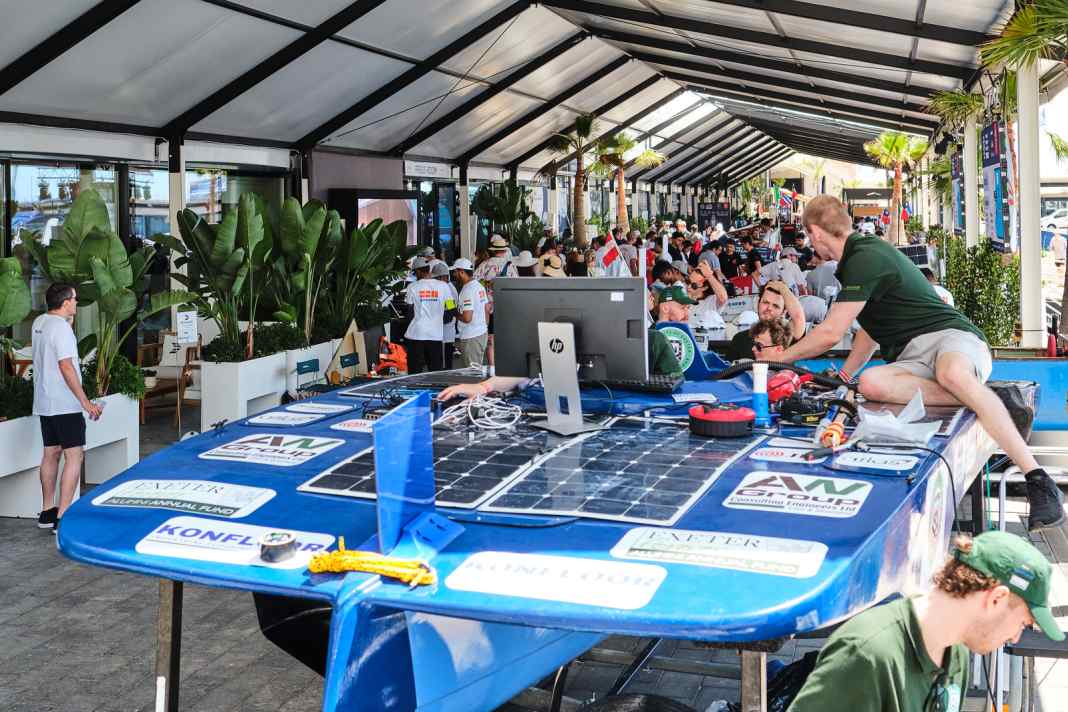





The fact that the Yacht Club de Monaco (YCM) is organising the Energy Boat Challenge is only logical given the club's history. In 1904, the YCM organised the first international motorboat competition in the Principality. Just 18 years earlier, Friedrich Lürßen had completed the world's first motorboat, the six-metre-long "Rems", on behalf of Gottlieb Daimler. The 11th edition of the Monaco Energy Boat Challenge was attended by 46 teams, 40 of them universities, with 450 people from 25 nations. The schedule included endurance and slalom races outside the Port Hercules and final races in the harbour basin. In addition, the aim was to achieve the maximum speed on a one-kilometre course - based on the 1904 competition.
Hydrogen teams on the rise
In the Energy Class, for which the Yacht Club de Monaco supplies standardised hulls, five of the 17 teams relied on hydrogen propulsion. University teams travelled from Chile, Indonesia, South Africa, Canada and India; the only German participants were called "Wannsea". The TU Berlin team finished in sixth place, with universities from Greece, Croatia and Italy leading the overall rankings. In the solar class, 13 teams competed, some of which constructed their hulls themselves and relied on foils. Once again, the Sunflare Solar Team from the Netherlands won ahead of the Portuguese.
There was a good atmosphere in the paddock below the Yacht Club de Monaco: the teams from Canada (Exocet), Cambridge University (Riviera Racing), UniGe from the University of Genoa and the Indonesians from Hydros Team UI exchanged equipment. After filling 30 cylinders, or six kilos of hydrogen, provided to five teams, the Dutch service provider SBM Offshore did not hesitate to provide the Cambridge team with batteries and cylinder connectors from its autonomous green hydrogen pontoon. On land, there were daily tech talks, a conference and a job forum where 90 job interviews took place between young engineers and shipyards such as Lürssen and Oceanco.
Safety at the top of the Energy Challenge
As the majority of participants started with prototypes, safety was the top priority. A technical committee monitored compliance with the regulations and checked all prototypes to guarantee safety at sea. Technical support, volunteers and the fire brigade were on site at all times. A technical incident at sea forced the pilot of the French Néréides team from the Energy class to abandon the boat in less than five seconds.
In the past, some countries struggled to pass the technical inspection, but today we see them with a home-built hydrogen battery hybridisation and an AI system to optimise their energy consumption"
Jérémie Lagarrigue, President of the international jury and CEO of EODev
Evoy cracked the 50-knot mark
In the Open Sea competition, 14 very different e-sports boats and RIBs competed against each other. Riva brought the El-Iseo De Antonio Yachts came to the Principality with the E-23 and the Swedes from Candela presented the only foiler in this class with the C-8. Also present were the Axopar 25 Electricwhich Maserati Tridente and the Spaniards from Madblue with the hydrogen-powered Marine P-01. The almost 18 metre long "Deep Silence" by Sialia from Poland was by far the longest starter. Evoy and Vita each had two boats at the start. Evoy's Goldfish X9 set a new record with a top speed of 56 knots and an average of 48.6 knots - last year it was 34.71 knots. The Vita Seal RIB travelled the furthest with 30 nautical miles.
At this year's Monaco Energy Boat Challenge, several teams used artificial intelligence (AI), including the Indians from Sea Sakthi with their navigation system. It takes the smallest obstacle into account and automatically calculates the fastest route from A to B. In collaboration with an Indian company, the team has also developed a networked ring that the pilot wears and that transmits data about their health status in real time. In the next edition, all teams can integrate AI into their project and compete in a special category.

